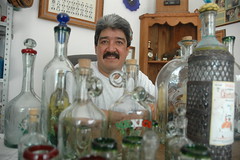Tonala hot shop weathers slump, churns out bottles for tequila makers

Photograph by : Farid Sanchez
Hipolito Gutierrez’s sweltering-hot shop churns out thousands of bottles each day, mostly for clients in the rapidly growing tequila industry.
Story by : DAVID AGREN
A worker in Hipolito Gutierrez’s Tonala workshop pulled a glob of molten glass from a 1,000-degree oven, retrieving it with a long metal tube. He dipped the orange ball in water to cool it slightly before rolling the glass on a metal surface. As he puffed into the tube several times, the glass began expanding. After placing it in a simple cylindrical mold, the glass took the shape of an elegant bottle. The worker finally spun the glass between a pair of tongs, giving the bottle near-perfect dimensions. Being a hand-made object, each creation is always slightly different than the one crafted before it.
Gutierrez’s sweltering-hot shop churns out thousands of bottles each day, mostly for clients in the rapidly growing tequila industry. His bottles’ rustic appeal give high-end liquors a special cachet. But at the same time as Gutierrez’s enterprise has thrived and gained notoriety, the blown-glass industry as a whole has fallen on hard times as foreign competition keeps taking market share from Jalisco’s producers. The Guadalajara-area’s blown-glass industry has been famous for decades and many kitchen cupboards are stocked with the ubiquitous fat, but imperfect glasses with blue rims. Nowadays, approximately 20 factories make glassware, a far cry from the 120 in business a decade ago.
“All the people that focused their businesses on making glassware ... they’re disappearing,” Gutierrez said.
The prices for normal drinking glasses, Guiterrez said, have stagnated in recent years.
“The prices that I charge for glassware are the same as they were in 2001.”
During the past five years, most producers’ input costs have kept increasing, eroding thin profit margins.
Somewhat fortuitously, Guiterrez focused his efforts on making bottles and shot glasses for the tequila industry in the early 1990s. Tequila bottles account for 90 percent of his shop’s production.
“The vast majority manufactures glassware, jars and flower vases,” he said.
“I’m focusing on something different.”
Something different includes the world’s largest blown-glass bottle, a 32-liter monster produced in 1997. The bottle broke his previous world record, a 22-liter bottle he made in 1996. His first record-setting bottle was made from seven kilograms of glass.
“It took more than 30 attempts,” he said, pointing to a row of bottles, which ascended in size, the smallest one representing his first attempt. The 22-liter bottle required a month of experimenting. The large bottles are now on display at a museum in Tequila, Jalisco.
Gutierrez still makes fairly big bottles, mainly three-liter containers – what Canadians and Americans might refer to as Texas mickies. He also now produces bottles for a Cognac maker, placing a decorative cluster of glass grapes in the bottom of each one.
For the tequila industry, Gutierrez said using a rustic decanter is an obvious way to market premium products, which can sell for several hundred dollars.
“They could put (tequila) in any type of bottle, but when a good product is combined with hand-made blown glass ... the bottle sells it,” he explained.
“More than anything, it’s different.”
Some of Jalisco’s most famous distillers use his bottles, including Cazadores, Herradura and Cabo Wabo.
Their patronage keeps his shop busy. Gutierrez’s 12 employees melt three tons of glass each day. An average bottle takes about eight to 10 minutes to create.
Despite his affinity for making bottles, Gutierrez makes some glassware – mainly shot glasses, which are mostly sold in souvenir shops in tequila-producing towns.
Adding to Gutierrez’s business success, he’s managed to keep a lid on some of his expenses. He switched from using liquid-petroleum gas for ovens to natural gas – a combustible available via networks running through a few suburban neighborhoods, but not in the municipality of Guadalajara, where memories of the April 22, 1992 sewer line explosions still linger. The change saved him at least 30 percent, he estimated. As an added benefit, natural gas burns cleaner, which leads to a better quality product. To save money, some competitors now burn oil in their ovens, which leads to the production of an inferior product and contaminates the glass.
“The advantage I have is natural gas,” he explained.
Another advantage is his reputation, which he gained while working in both his own workshop, which opened 12 years ago, and with five brothers in a family business before that. Gutierrez’s father helped pioneer the blown-glass industry in Jalisco, back when “there were only two factories.” Gutierrez’s two teenage daughters, though, aspire to other things, even though he said his blown-glass workshop has “a bright future.”
From the Guadalajara Reporter


0 Comments:
Post a Comment
<< Home